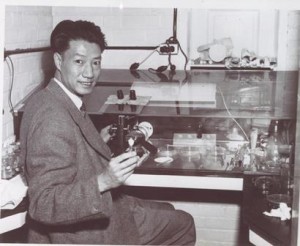By Melanie Petrucci, Contributing Writer

Shrewsbury – At a recent lecture sponsored by the Shrewsbury Historical Society, three local history buffs gave a presentation that delved into the role that Shrewsbury played in the revolution of human sexuality.
Shrewsbury Historic District Commission (HDC) Chair John Campbell, Shrewsbury Historical Society President Erik Larson and Shrewsbury resident and scientist Clare O’Connor gave a three-part presentation on the history of the birth control pill that was developed in Shrewsbury, titled “Worcester Foundation for Experimental Biology.” Larson’s portion of the presentation centered on the Worcester Foundation, while O’Connor addressed the science behind “the pill” and Campbell focused on its players.
When asked about his involvement with this project, Campbell replied, “Shrewsbury’s Worcester Foundation for Experimental Biology is world renowned for being the place where Dr. Gregory Pincus, Dr. Min Chueh (M.C.) Chang and Dr. Hudson Hoagland developed the first oral contraceptive, the birth control pill….a lot of young people don’t realize that this is a significant part of Shrewsbury’s history… I’m just a history buff and I have done a couple of other presentations on other historical topics.”
“The pill” is the result of a collaboration of several people who came together at a time when there were changing attitudes about sex and concerns about over population. Jonathan Eig, author of “The Birth of the Pill” published in 2014, said in an article from the Worcester Telegram & Gazette dated Oct. 27, “We take it for granted that women can go to college, and postpone having children and start their careers…. It required some really gutsy and brilliant work by some crusaders.”
Society can thank these crusaders for taking risks on a common mission at a time when working on birth control was illegal in Massachusetts. Pincus, a professor and reproductive scientist from Harvard University, was brought by friend Hoagland, chair of the Biology Department at Clark University, to Clark in 1938 to teach. Hoagland himself was a graduate of Columbia University with a master’s degree from the Massachusetts Institute of Technology (MIT) in chemical engineering and a Ph.D. from Harvard. Together, in 1944, they founded the Worcester Foundation for Experimental Biology in Shrewsbury. Additionally, and perhaps most importantly, there was Chang. Chinese born and educated in China as well as at Edinburgh and Cambridge universities, he was brought to the Worcester Foundation in the mid-1940s as a research fellow by Pincus. He was the chief researcher who guided his team, leading the way in reproduction research and instrumental as a cofounder of oral contraception. His widow, Isabella, still resides in Shrewsbury.
One critical component was needed – funding. Margaret Sanger and Katherine McCormick, both well-known in women’s advancement, made the acquaintance of Pincus in the early 1950s. This introduction was critical in establishing the connection for the funding that Pincus needed for the pill’s development. Sanger, a nurse from New York and an early birth control pioneer, had a personal reason for advocating for birth control. According to a PBS documentary on Sanger, “her commitment to birth control sprung from personal tragedy. One of 11 children born to a working class Irish Catholic family in Corning, New York, at age 19 Margaret watched her mother die of tuberculosis. Just 50 years old, her mother had wasted away from the strain of 11 childbirths and seven miscarriages.”
Sanger founded the organization now known as Planned Parenthood.
McCormick, biologist and graduate of MIT, philanthropist and a passionate suffragist, worked to help ratify the 19th Amendment granting women the right to vote. It was during this time that she met Sanger and the two began collaborating on birth control issues. The last primary player was Dr. John Rock. A Marlborough native and graduate of Harvard University, Rock was an obstetrician, gynecologist and pioneer in sperm freezing and in-vitro fertilization. He was recruited to run the clinical trials of the pill on humans. Much of the research and trials were conducted in secret as it was illegal in Massachusetts at the time.
The pill was ultimately born in 1955 when, after successful trials and the word spreading through scientific circles, the team created its first oral contraceptive. Under the brand name Enovid, it was approved by the Food and Drug Administration in 1957 for the sole purpose of regulating menses. It wasn’t until 1960 that it gained approval for use as an oral contraceptive, ensuring Shrewsbury’s legacy as the birthplace of the pill and the epicenter of the sexual revolution.















